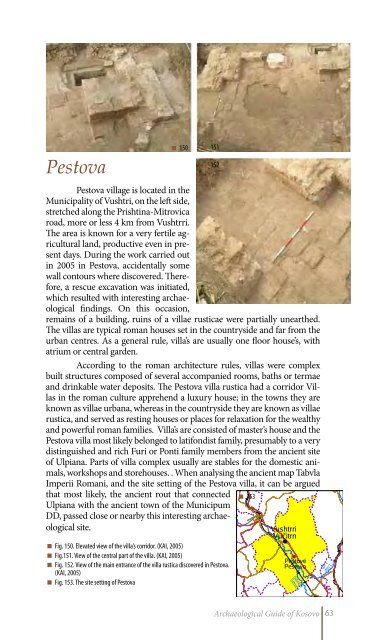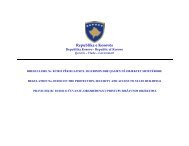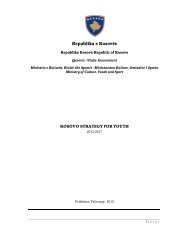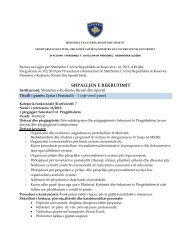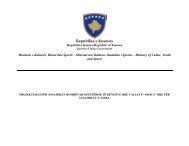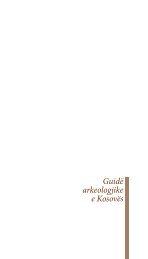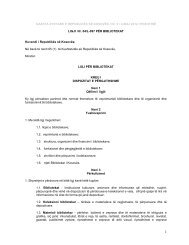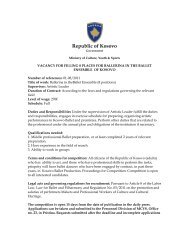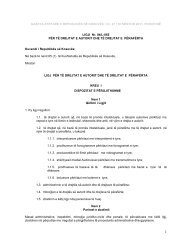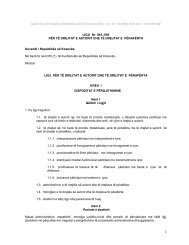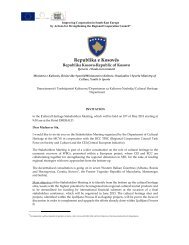Archaeological Guide of Kosovo
Archaeological Guide of Kosovo
Archaeological Guide of Kosovo
You also want an ePaper? Increase the reach of your titles
YUMPU automatically turns print PDFs into web optimized ePapers that Google loves.
Pestova<br />
150 151<br />
152<br />
Pestova village is located in the<br />
Municipality <strong>of</strong> Vushtri, on the left side,<br />
stretched along the Prishtina-Mitrovica<br />
road, more or less 4 km from Vushtrri.<br />
The area is known for a very fertile agricultural<br />
land, productive even in present<br />
days. During the work carried out<br />
in 2005 in Pestova, accidentally some<br />
wall contours where discovered. Therefore,<br />
a rescue excavation was initiated,<br />
which resulted with interesting archaeological<br />
findings. On this occasion,<br />
remains <strong>of</strong> a building, ruins <strong>of</strong> a villae rusticae were partially unearthed.<br />
The villas are typical roman houses set in the countryside and far from the<br />
urban centres. As a general rule, villa’s are usually one floor house’s, with<br />
atrium or central garden.<br />
According to the roman architecture rules, villas were complex<br />
built structures composed <strong>of</strong> several accompanied rooms, baths or termae<br />
and drinkable water deposits. The Pestova villa rustica had a corridor Villas<br />
in the roman culture apprehend a luxury house; in the towns they are<br />
known as villae urbana, whereas in the countryside they are known as villae<br />
rustica, and served as resting houses or places for relaxation for the wealthy<br />
and powerful roman families. Villa’s are consisted <strong>of</strong> master’s house and the<br />
Pestova villa most likely belonged to latifondist family, presumably to a very<br />
distinguished and rich Furi or Ponti family members from the ancient site<br />
<strong>of</strong> Ulpiana. Parts <strong>of</strong> villa complex usually are stables for the domestic animals,<br />
workshops and storehouses. . When analysing the ancient map Tabvla<br />
Imperii Romani, and the site setting <strong>of</strong> the Pestova villa, it can be argued<br />
that most likely, the ancient rout that connected<br />
Ulpiana with the ancient town <strong>of</strong> the Municipum<br />
DD, passed close or nearby this interesting archaeological<br />
site.<br />
Fig. 150. Elevated view <strong>of</strong> the villa’s corridor. (KAI, 2005)<br />
Fig.151. View <strong>of</strong> the central part <strong>of</strong> the villa. (KAI, 2005)<br />
Fig. 152. View <strong>of</strong> the main entrance <strong>of</strong> the villa rustica discovered in Pestova.<br />
(KAI, 2005)<br />
Fig. 153. The site setting <strong>of</strong> Pestova<br />
153<br />
<strong>Archaeological</strong> <strong>Guide</strong> <strong>of</strong> <strong>Kosovo</strong> 63


